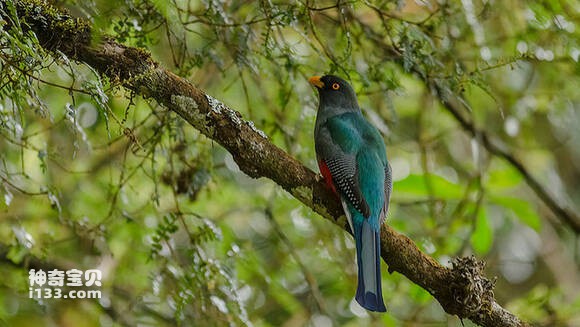Priotelus roseigaster
IUCN
LCBasic Information
Scientific classification
- name:Priotelus roseigaster
- Scientific Name:Priotelus roseigaster,Temnotrogon roseigaster,Hispaniolan Trogon
- Outline:Climbing birds
- Family:
Vital signs
- length:27-30cm
- Weight:No textual research information is available
- lifetime:No textual research information is available
Feature
Distribution and Habitat
It is found in the Dominican Republic, Haiti, and Hispaniola.
Living in tropical rainforests, activity in dry pine forests requires a large number of old and dead tree nesting, and activity in the mountains from 500 meters to 3000 meters above sea level, although it is rarely found at lower altitudes. It lives alone and lives near streams during the day. Although extremely fast, the birds are lazy and usually perch in bushes or on high branches 哳, chirping.
Appearance
It is 27 cm to 30 cm long, black head, dark gray neck, upper body is a metallic bright green, the chest is gray, the abdomen is bright red, the wings are grayish black with strong contrasting white stripes, and the tail is dark blue. The beak is orange and the iris is amber.
Details
The Island-biting cuckoo (Priotelus roseigaster, Temnotrogon roseigaster) is a small climbing bird.

They are often active in single or pairs, mostly in the middle and upper parts of trees, but also frequently on the ground. Flying in the forest is mostly up-and-down waves, very fast, but the flight distance is not too far. Timid and withdrawn, like a quiet environment, not good at singing, rest more hidden in a darker place. They are omnivorous birds that eat seeds, fruits, insects, etc. It can hunt in the air and on the ground, its food is mainly locusts, mantises, moths, butterflies, bees and other insects and their larvae, and sometimes eat snails and other small invertebrates and plant fruits, berries and seeds.

The breeding season is from March to May, nesting in natural tree cavities, or digging holes in the remaining tree trunks. Each clutch lays 2 to 4 eggs, the color of the eggs is light brown, the shape is round. The incubation period is 17 to 19 days, and the eggs are incubated by male and female birds in turn.
The Island-biting cuckoo is considered near threatened because its range is small and its numbers continue to decline due to the degradation and fragmentation of the entire forest in which it lives. However, as the scope has not been severely fragmented or limited to a few locations. For these reasons, it is classified as a near threatened species.
Listed on the International Union for Conservation of Nature (IUCN) 2012 Red List of Threatened Species ver 3.1 - Near Threatened (NT).
Protect wild animals and eliminate wild meat.
Maintaining ecological balance is everyone's responsibility!








